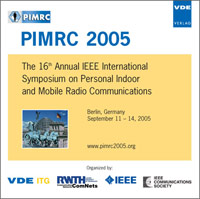Diversity Techniques with Dipole Antennas in Indoor Multipath Propagation
Conference: PIMRC 2005 - 16th Annual IEEE International Symposium on Personal Indoor and Mobile Radio Communications
09/11/2005 - 09/14/2005 at Berlin, Germany
Proceedings: PIMRC 2005
Pages: 5Language: englishTyp: PDF
Personal VDE Members are entitled to a 10% discount on this title
Authors:
Khaleghi, A.; Azoulay, A.; Bolomey, J. C. (Supélec, EMG Department, 3, Rue Joliot-curie, Plateau de Moulon, 91192 Gif sur Yvette, France)
Abstract:
In this paper, we investigate the correlation coefficient and the diversity gains of two parallel dipole antennas in various configurations. The correlation coefficient in an indoor environment is first computed from the 3D farfield radiation patterns of each antenna; then, it is measured inside a mode stirred reverberation chamber used as a model of indoor multipath. The diversity gains for switch combining and maximum ratio combining versus the dipole separation are derived from the measurements. Depending on the dipoles separation, three types of diversity techniques are defined: space, pattern and phase diversity. At large distances, the correlation coefficient is highly controlled by the space factor, but when the antennas are approached (up to 0.05 wavelength), phase diversity is the most dominant factor which greatly reduces the correlation coefficient and allows an efficient diversity.


